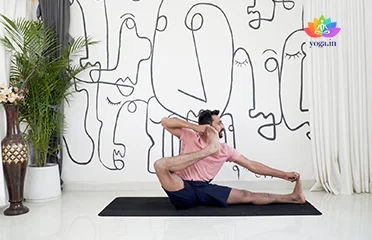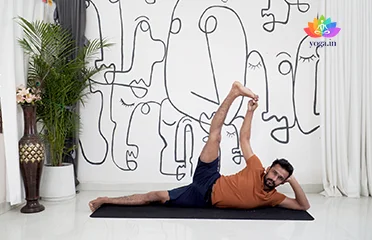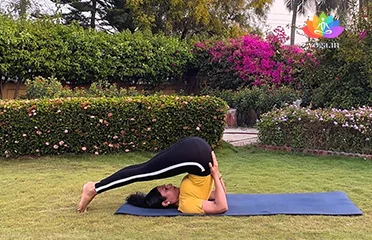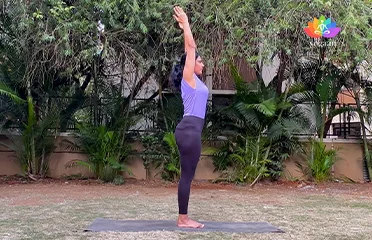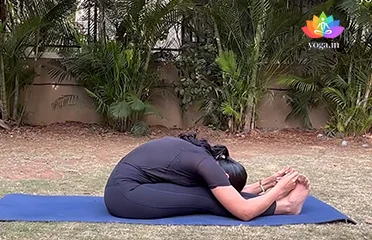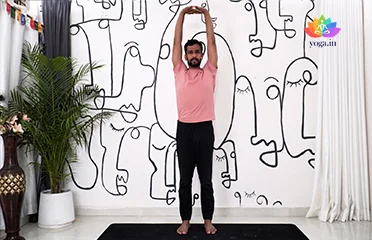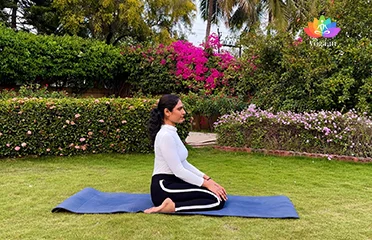Akarna Dhanurasana (Archer Pose)
अकर्णा धनुरासन / Archer Pose
The Sanskrit name is derived from Akarna (अकर्णा ) meaning towards [�K]
Anantasana (Sleeping Vishnu Pose)
अनन्तासन / Sleeping Vishnu Pose | Vishnu's Couch Pose
The Sanskrit name is derived from Ananta (अनन्त) meaning without end [�K]
Halasana (Plough Pose)
हलासन / Plough Pose
The Sanskrit name is derived from Hala (हला) meaning plough and asana [�K]
Hastapadasana (Hand to Foot Pose)
हस्तपदासन / Hand to Foot Pose
The sanskrit name is derived from hasta (हस्त) means hands, pada (पदा) [�K]
Paschimottanasana (Seated Forward Bend)
पश्चिमोत्तानासन / Seated Forward Bend
The Sanskrit name is derived from three sanskrit words: Paschima (पश्चिमा) [�K]
Tadasana (Mountain Pose)
ताड़ासन / Mountain Pose
The sanskrit name is derived from tada (ताड़ा) meaning mountain and [�K]
Virasana (Hero Pose)
वीरासन / Hero Pose
The Sanskrit name is derived from Vira (वीरा) meaning hero or a warrior [�K]
How Yoga Can Help Cure Palpitation:
Palpitation is the sensation of feeling your heart beating irregularly, too quickly, or too strongly. Yoga can significantly aid in managing palpitations by promoting relaxation, reducing stress, and improving overall cardiovascular health. Through specific postures, breathing exercises, and meditation, yoga helps regulate heart rate and fosters a sense of calm.
Understanding Palpitation:
Palpitation is the awareness of one’s heartbeat that can feel like fluttering, pounding, or irregular beats. It can occur due to various reasons such as stress, anxiety, excessive caffeine intake, or heart conditions. While often harmless, palpitations can sometimes indicate an underlying medical issue and may need medical attention.
Yoga’s Role in Relieving Palpitation:
Specific yoga practices can help alleviate the symptoms of palpitations by calming the nervous system, improving heart health, and reducing stress. Gentle asanas (postures), pranayama (breathing exercises), and meditation can all contribute to a balanced heart rate and overall sense of well-being.
Key Factors Contributing to Palpitation:
Several factors can contribute to the development of palpitations, including:
- Stress and Anxiety: Emotional stress and anxiety can trigger palpitations.
- Stimulant Use: Consumption of caffeine, nicotine, or certain medications.
- Hormonal Changes: Menopause, menstruation, or pregnancy can cause palpitations.
- Heart Conditions: Arrhythmias or other heart-related issues.
- Electrolyte Imbalances: Low levels of electrolytes like potassium or magnesium.
- Physical Activity: Overexertion or intense exercise.
Symptoms of Palpitation:
Common symptoms of palpitations include:
- Fluttering Sensation: Feeling of fluttering or rapid beating in the chest.
- Pounding Heart: A strong or irregular heartbeat.
- Skipped Beats: Perception of missed or extra heartbeats.
- Shortness of Breath: Difficulty in breathing during palpitations.
- Dizziness: Feeling lightheaded or dizzy.
- Chest Discomfort: Mild pain or discomfort in the chest.
Treatment of Palpitation through Yoga and Pranayama:
Yoga and pranayama can be very beneficial in managing palpitations. Some effective practices include:
Specific Yoga Poses:
- Balasana (Child’s Pose): Promotes relaxation and reduces stress.
- Setu Bandhasana (Bridge Pose): Opens the chest and improves circulation.
Pranayama Exercises:
- Anulom Vilom (Alternate Nostril Breathing): Balances the mind and reduces stress.
- Bhramari (Bee Breath): Calms the mind and reduces stress levels.
Diet for Palpitation:
A balanced diet can help manage palpitations. Recommendations include:
- Magnesium-Rich Foods: Spinach, almonds, and avocados support heart health.
- Potassium-Rich Foods: Bananas, sweet potatoes, and beans help regulate heartbeat.
- Omega-3 Fatty Acids: Found in fish, flaxseeds, and walnuts, these support cardiovascular health.
- Hydration: Drinking plenty of water to maintain electrolyte balance.
- Avoid Stimulants: Limit intake of caffeine, alcohol, and nicotine.
Caution for Palpitation:
While practicing yoga for palpitations, it is essential to:
- Avoid Overexertion: Practice at a gentle pace to prevent strain on the heart.
- Be Mindful of Symptoms: Stop immediately if any pose causes discomfort or increases palpitations.
Always consult with a healthcare provider before starting any new exercise regimen, especially if you have severe or frequent palpitations.
Contraindications for Palpitation:
Individuals with severe palpitations or significant heart conditions should:
- Avoid High-Intensity Yoga: Vigorous exercises might exacerbate symptoms.
- Steer Clear of Inversions: Poses like headstands can increase heart strain.
- Seek Professional Guidance: Consult a yoga therapist or healthcare professional for personalized recommendations.


